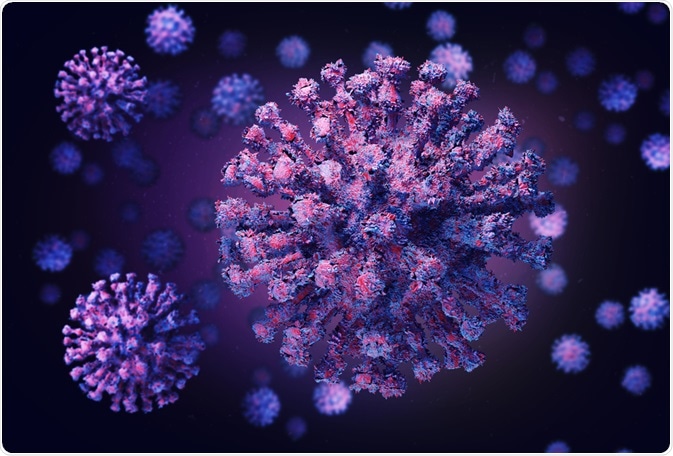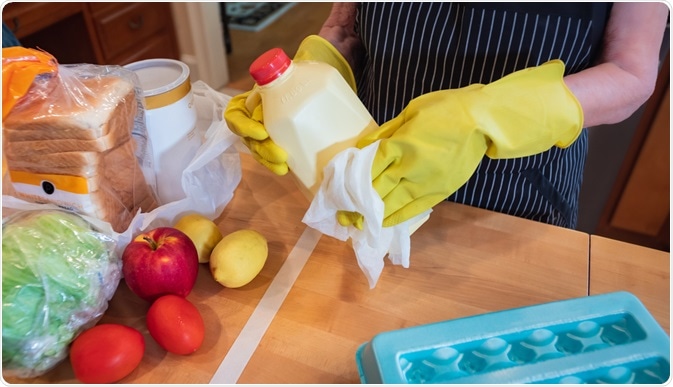The primary mode of transmission for the novel severe acute respiratory syndrome coronavirus 2 (SARS-CoV-2) between humans is through respiratory droplets that are dispersed through talking, sneezing, coughing, or direct contact with infected individuals.

SARS-CoV-2 Virus. Image Credit: iunewind/Shutterstock.com
Additional carriers that have also been found to be significant transmission routes of infection include the consumption of food that has been served on contaminated surfaces and/or packaged in certain contaminated materials.
Contaminated surfaces
Although the previous understanding of how SARS-CoV-2 can spread from contaminated surfaces has been limited, recent studies have provided new scientific evidence on the infectious potential of these surfaces.
For example, studies have found that SARS-CoV-2 can survive on the surfaces of polyvinyl chloride (PVC), polyfluorotetraethylene (PFTE), glass, ceramic tiles, and stainless steel for at least 5 days. When SARS-CoV-2-contaminated stainless steel and plastic surfaces were present in an area with humidity of around 40% and an ambient temperature between 21 °C and 23 °C, the virus was found to survive for 2 and 3 days, respectively.
Comparatively, SARS-CoV-2 has been found to survive on silicon rubber surfaces for 3 days at 21 °C with a relative humidity of 30-40%. As compared to these longer survival times, SARS-CoV-2 was not found to survive on copper and cardboard surfaces after 4 and 24 hours, respectively.
Food packages
Both the Food and Agriculture Organization of the United Nations (FAO) and the World Health Organization (WHO) have stated that touching SARS-CoV-2 contaminated food packages or containers could potentially serve as a route of viral transmission to the mouth, nose, and/or eyes.
Despite this announcement, the survival of SARS-CoV-2 on the surfaces of food packages/containers is considered to be negligible to very low. The potential foodborne transmission of SARS-CoV-2 is more likely to occur as a result of the consumption of foods originating from infected animals and/or cross-contaminated foods.
Nevertheless, there remains an urgent need to better understand how SARS-CoV02 can be transferred from the respiratory tract of an infected individual to food package surfaces or through food consumption.
Due to the lack of scientific evidence on this potential transmission route, federal agencies like the Food and Drug Administration (FDA) of the United States have provided sanitation and hygienic practice guidelines that consumers should abide by while shopping, handling, and/or preparing food products.

Food Safety. Image Credit: The Toidi/Shutterstock.com
Food products
It is well known that many of the first reported cases of the coronavirus disease 2019 (COVID-19) were associated with individuals who had previously visited the Huanan seafood wholesale market. At this market, live animals including bats, snakes, and marmots, as well as the organs of certain animals, were sold close to seafood and meat products.
The proximity between the live wild animals and food products suggests the zoonotic transmission of SARS-CoV-2, in which the primary host was likely to be bad, whereas other animals including pigs or pangolins are believed to be the secondary hosts to the virus. While the exact origination of SARS-CoV-2 is not fully understood, many federal authorities including WHO, the FDA, and the European Food Safety Authority (EFSA) continue to gather information on the potential persistence of SARS-CoV-2 in food products.
Heparin sulfate, which is abundant in meat derived from beef, poultry, pork, and other wild animals, is required for SARS-CoV-2 to interact with host tissue epithelia. Therefore, the persistence of SARS-CoV-2 on some of the aforementioned surfaces can become an issue when potentially contaminated meat products are placed on these surfaces and not cleaned properly.
While this assumption has been made, there remains a general lack of information on the persistence of coronaviruses in food products. One recent study found that SARS-CoV-2 remained viable in salmon stored at 4 °C and 25 °C for 8 and 2 days, respectively. This information, therefore, supports the need to inspect various food items, particularly meat, poultry, and seafood, that have been stored at low temperatures to ensure food safety against SARS-CoV-2.
Control measures for SARS-CoV-2 in the food industry
The limited information on the transmissibility of SARS-CoV-2 from the food industry has not deterred this industry from incorporating a greater number of viral inactivation and control methods. One of the best practices that can likely reduce the spread of COVID-19 is the disinfection of environmental surfaces, both within the food industry as well as in household settings. Some of the known chemical agents that can inactivate coronaviruses like SARS-CoV-2 including solutions of various concentrations of hypochlorite, ethanol, or hydrogen peroxide.
Household bleach, 70% ethanol, 0.05% povidine-iodine chloroxylenol, 0.05% chlorhexidine, and 0.1% benzalkonium chloride solutions were all found to eliminate any traces of SARS-CoV-2 after 5 minutes of treatment with any of these agents.
As previously mentioned, the persistence of SARs-CoV-2 on food packaging materials and even food products appear to be temperature-dependent. As a result, several heat inactivation methods have been successfully applied for food safety purposes. SARS-CoV-2 appears to be unstable when exposed to heat; however, this decontamination method is limited in its applicability to fresh food products.
Another type of viral inactivation method that has been evaluated includes ultraviolet (UV) treatment, as most viruses are vulnerable to UV at wavelengths of approximately 253.7 nanometers (nm). Similarly, SARs-CoV-2 has been successfully inactivated by several different doses of UV radiation; therefore, further studies must be conducted to quantify exposure time and doses that can be applied to large-scale inactivation procedures.
Sources
- Han, S., Roy, P. K., Hossain, M. I., et al. (2021). COVID-19 pandemic crisis and food safety: Implications and inactivation strategies. Trends in Food Science & Technology 109; 25-36. doi:10.1016/j.tifs.2021.01.004.
- Olaimat, A. N., Shahbaz, H. M., Fatima, N., et al. (2020). Food Safety During and After the Era of COVID-19 Pandemic. Frontiers in Microbiology 11(1854). doi:10.3389/fmicb.2020.01854.
- Anelich, L. E. M., Lues, R., Farber, J. M., & Parreira, V. R. (2020). SARS-CoV-2 and Risk to Food Safety. Frontiers in Nutrition. doi:10.3389/fnut.2020.580551.
Further Reading
Last Updated: Feb 19, 2021